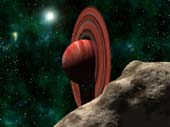
— H. G. Wells, War of the Worlds
|
Origins Table of Contents |
|
More Information |
A rare treat to backyard astronomers who view the skies, the planets in our solar system are especially well studied by astronomers and planetary geologists. The motions of the planets have been well established for centuries, the chemical abundances in their atmospheres have been analyzed more recently and the changes in their structure, atmospheres and physical appearance have been noted with repeated observations from ground- and space-based observatories. We, as a scientific community, know the planets quite well, enough to make predictions on the possibility of finding planets around other nearby stars.
Or do we?
The detection of planets outside our solar system
Until the 1990s, the nine planetary members of our own solar system were the only known planets. Astronomers did not believe that our Sun's environment was particularly unique to be the only planet producer in the universe. However, there had not yet been any evidence of other planets outside our solar system. This was a product of not only the length of time astronomers were trying to note changes in other stars due to the existence of orbiting planets, but by state-of-the-art optical and spectroscopic instruments that were limited in spectral and spatial resolution. But how quickly things changed.
In 1991 radio astronomers detected the first extrasolar planets orbiting none other than a dying pulsar star. This star was left over from a supernova explosion in the constellation Virgo. The pulsar's beam of radiation changed slightly due to the gravitational pull of three Earth-sized objects revolving around the host star, PSR B1257+12. Although the deadly radiation from the pulsar is not condusive to any of the planets being life-bearing, it was the first example of a star other than our Sun producing planets.
In 1995 Swiss astronomers found another extrasolar planetary candidate. It was discovered by noting a slight perturbation in the position of 51 Pegasi, a star in our nearby galactic neighborhood. This star, found in the constellation of Pegasus, is much more like our Sun with respect to its temperature, size, rotation speed and emitted radiation. The newly found planet orbiting 51 Peg had a size comparable to Jupiter or Saturn, however, it was positioned extremely close to its parent star- at a position closer than Mercury sits from our own Sun! Although not a good candidate for a life-bearing planet, it was the first ever evidence of an extrasolar planet around a Sun-like star.
Since then several other Jovian-sized planets have been found orbiting other Sun-like planets. Some of them are orbiting extremely close to their parent star like the 51 Peg planetary system, while others are found to be at distances comparable to where Mars and Jupiter lie in our solar system.